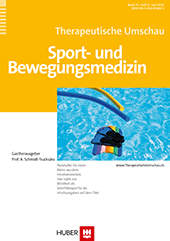Trainingsprinzipien im gesundheitsorientierten Freizeitsport
Exercise guidelines for health-oriented recreational sports
Abstract
Körperliche Inaktivität ist eines der größten Public Health Probleme des 21. Jahrhunderts. Sport und körperliche Aktivität haben erhebliche positive Auswirkungen auf die Gesundheit und können bei einigen Erkrankungen vergleichbare Effekte wie pharmakologische Wirkstoffe erzielen. Das Ziel dieser Arbeit ist es, evidenzbasierte Empfehlungen zur Gestaltung von Sport bzw. Training in der Primärprävention zu geben. Auf Basis des aktuellen Forschungsstandes kann davon ausgegangen werden, dass eine Dosis-Wirkungs-Beziehung zwischen sportlicher Aktivität und Gesundheitsmarkern sowie körperlicher Leistungsfähigkeit besteht. Ein adäquates Trainingsprogramm sollte einen zusätzlichen Energieumsatz von mindestens 1000 kcal pro Woche durch ein Training des Herz-Kreislauf-Systems, des Stoffwechsels sowie der muskulären Fitness ermöglichen. Funktionelles Training und Beweglichkeitstraining sollten das Training ergänzen. Im Einzelfall müssen immer auch mögliche Risiken und Nebenwirkungen wie beispielsweise Verletzungen oder die Gefahr schwerwiegender kardialer Ereignisse berücksichtigt werden. Sportarten, die mehrere Komponenten der körperlichen Leistungsfähigkeit gleichzeitig trainieren (z. B. Fußball, Tanz, Tai Chi), können gesundheitlich positive Effekte induzieren. Trainingsempfehlungen sollten individuelle Bedürfnisse und die Tatsache, dass verschiedene Individuen auf gleiche Trainingsinhalte unterschiedlich reagieren, berücksichtigen, sodass eine dauerhafte Umstellung auf einen sportiven Lebensstil unterstützt wird.
Physical inactivity is one the biggest Public Health problems of the 21th century. Regular physical activity and sports can contribute to a reduction of overall mortality and morbidity and, thus, can have a considerable health impact for individuals as well as for the society as a whole. The beneficial health effects of exercise are convincingly evaluated yet and there is further evidence that physical activity can result in improvements in specific cardiorespiratory and metabolic diseases similar to pharmacological treatments. It is the aim of this review article to outline evidence-based guidelines for exercise to improve physical fitness and health in primary prevention in healthy adults. Based on the current scientific evidence a dose-response-relationship between physical activity and health markers as well as physical fitness is likely. Health-oriented exercise training should allow for an exercise-induced energy expenditure of at least 1000 kcal per week. This should be approached by an appropriate combination of exercises targeting on an improvement in cardiorespiratory and metabolic functioning as well as muscular fitness. It is recommended to supplement such a training regimen by appropriate amounts of functional and flexibility exercises. Usually, sports targeting on these particular fitness areas are recommended, for instance, typical endurance sports like cycling, jogging, (Nordic) walking or swimming for the cardiorespiratory and metabolic domains and strength training for muscular fitness. In recent years, scientific studies have evaluated potentially more attractive sports like football, dancing and Tai Chi and reported promising results. Such sports may contribute to an increased long-term compliance to health-oriented exercise programmes. Although regular physical activity is associated with considerable health benefits, risks and side effects should be taken into account. The most frequent side effects are injuries, and the most severe are fatal cardiac events. Preventive measures should be applied to reduce the risk of these side effects. Health-oriented exercise guidelines should incorporate individual preferences and training responses to support a permanent adaptation towards a sportive life style.



